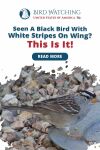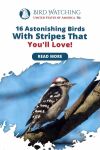
What’s This Post About?
Many bird watchers find themselves getting curious about birds for several reasons. Sometimes they want to know whether a particular bird migrates or not, and other times, they are interested to know specific characteristics related to a specific bird’s structure.
This post talks about short-legged little beings in great detail. Most of the birds are easy to identify because of their adorable tiny legs. Well, good news for you, there are different types of birds with short legs that you’ll love reading about. We’ve prepared a list for you to look at.
There are multiple types of birds that have short legs. Some popular ones include Ruby-throated Hummingbirds, drongos, bluebirds, tufted titmouse, house sparrows, northern cardinals, swifts, and ducks.

Different Types of Short-legged Birds
Have you ever sighted a small bird with even smaller legs, small enough to make it look as though they don’t have any? If so, did it make you think how these tiny little creatures manage to walk on their feet when they land or maybe wondered if they walk at all? If so, then you’re not alone.
Bird watchers often find themselves intrigued by these little details that no one else notices. And to answer your questions about these short-legged birds, we have compiled a list of birds with tiny legs for you to look into.
Keep on reading to learn more about them.
1. Ruby-throated Hummingbird
These birds can beat their wings 50 times consecutively in a second.

The ruby-throated hummingbird is a beautiful bird that inhabits Central America, Florida, and Mexico in winters and travels to Canada for breeding in summers.
-
Measurements
-
Length: 7-9 cm
-
Weight: 2-6 g
-
Wingspan: 8-11 cm
-
Leg band: 0.001 gram
Ruby-throated hummingbirds have a small body structure, but their wingspan is long. Males are black, with bright red throats and green crowns. On the other hand, females are a mixture of white and green.
They can fly at an excellent speed. However, their short legs can cause them hindrance when they try to walk or hop.
People find it difficult to spot their legs because they are super tiny and barely visible. They’re usually folded in. This causes most people to think that they do not have legs. Additionally, these cheery birds cannot even scratch their head or neck without raising their feet upwards.
2. Tufted Titmouse

This bird belongs to the chickadee family, and the Tufted titmouse is a tiny songbird that originated from North America and is found there abundantly.
These chunky and small birds have large, dark eyes. They appear fluffed out and stuffed because of their enormous head and stocky necks. However, they have a v-shaped crest, thick beak, and incredibly tiny and thin legs, which can aid people in identifying them.
Fun Fact
A tufted titmouse uses its feet to hold and break the seeds.
Their color pattern includes silver-gray patches above and white underneath, with shades of faded peach in the feathers. They are also known for their tunes and melodies, as they are often heard singing during spring and summer.
-
Measurements
-
Length: 14-16 cm
-
Weight: 18-26 g
-
Wingspan: 20-26 cm
These stocky birds stay around parks, backyards, and gardens. Most of them also prefer living in woodland areas and forests. They often travel in flocks with other similar birds when they are visiting feeders.
Although these non-migratory birds have super tiny and thin legs, they still have a unique trait of hanging upside down to feed themselves.
3. Ducks

Ducks, also known as water birds, are usually found in or around the sea, lakes, or canals. If you live close to water bodies and coastal lines, you might see these birds walking around casually in your neighborhood or even your backyard.
These birds can be seen across the globe, usually in places with access to fresh water. However, they mostly live in North America, Europe, and Asia.
Did You Know?
Ducks are present on every continent except Antarctica.
You might misinterpret swans and geese as ducks. However, a few differences in their body structure can help you distinguish between these three birds. Ducks are relatively smaller than swans and geese as they have shorter necks, wings, and legs than them.
Ducks have webbed feet alongside tiny legs that allow them to swim. In addition, they can broaden their feet, which increases the surface area of their body structure and will enable them to swim.
The mallard is a wild duck that belongs to the subfamily of the waterfowl family Anatidae. The male mallards have shiny green heads, and their wings have patches of grey on them. The females, on the other hand, are primarily brown.
-
Measurements
-
Length: 50-65 cm
-
Wingspan: 81-98 cm
-
Bill: 4.4-6.1 cm
-
Weight: 0.7-1.6 kg
Ducks have short legs that are well-built and strong – they allow them to do both, float and swim in the water. In addition, they have a unique characteristic; their feet do not feel cold since they do not have blood vessels or nerves in their feet, even if they swim in water as cold as ice.
4. House Sparrows

The bird generally found close to human habitats originates from the family Passeridae and is quite possibly the most widely recognized bird. These little birds have a short life expectancy of three years, have a length of 16cm, and weigh between 24 to 39.5 grams.
The male house sparrows have dull grey heads, a rosy earthy-colored neck, and patches of black on the chest and plumage. The female house sparrows, however are generally brown with shades of grey underneath.
Did You Know?
The longest a house sparrow has lived for is 23 years.
These round-headed birds appear to be unique when contrasted with different sparrows due to their shape. They have a stocky chest, round head, a small tail, and a more plumped-up snout than the remainder of the North American sparrows.
House sparrows love to stay around humans and feel at home in their backyards and gardens. They have small and thin legs that are scarcely apparent. Nonetheless, if you spot their legs, you will notice that they have pale beige feet.
5. Swifts

The swifts are aerial birds that belong to the family Apodidae. They resemble Swallows but are not closely related to any passerine species.
Their length ranges from 9 to 23 cm. These medium-sized aerial birds have an extraordinarily long wingspan. The color of their plumage is dull-brown, whereas the rest of the body parts are primarily white.
-
Measurements
-
Length: 16-17cm
-
Wingspan: 42-48cm
-
Weight: 32-50g
This speedy bird has a broad head with a small and slightly down-curved bill. Most of the swifts have a short tail; however, it could be a bit long in some cases.
Fun Fact
Swifts are monogamous, as they mate with a single partner forever.
Unfortunately, their feet are skinny, small, and weak. If they want to climb to vertical places, they use their claws instead of their feet. They avoid landing on the ground because once they do, it becomes difficult for them to fly again.
6. Eastern Bluebirds

Bluebirds are also passerine birds, but they belong to the thrust family. People believe that the best part about the Bluebirds is their color.
They sing a specific song which can be heard as ‘chur-lee, chur-lee’, a method that can be used to distinguish them from blue jays and other birds.
These short-beaked birds are primarily found across the United States and Canada and prefer to live in woodlands, orchards, and farmlands.
Did You Know
Bluebirds are only found in North America.
The Eastern Bluebird is a small to medium-sized songbird with a large and circular head. They have a chunky, plumped-up body with large eyes. These chirpy birds have a long wingspan but the tail and legs, in specific, are extremely short.
Male bluebirds have vibrant and dark blue upper parts, whereas the throat and chest are reddish-brown.
These birds consist of a gray pigment, but they appear blue because of a phenomenon known as light scattering. If you look at them at a distance, they will appear gray-brown instead of blue.
On the other hand, female bluebirds have gray upperparts, blue tails and wings, and a red-orange chest.
- Measurements
Both sexes have the following measurements:
-
Length: 16-21cm
-
Weight: 28-32g
-
Wingspan: 25-32cm
People think that if you hold the bluebird in your hand, their legs will break because they are so small and thin.
7. Drongos

The drongos, also known as fork-tailed drongos, are passerine birds, and they belong to the family Dicruiridae.
They are found in continents like Africa and Asia and are widely spread in Australia as well. If you search for these astonishing birds, you will find them in gardens and inhabiting forests.
Fun Fact
Drongos are one of the most common birds of South Asia.
These insect-eating birds are 25 cm long and have short legs, with an average weight of 50 grams. These aggressive birds are short-legged; however, their feet are powerful.
The male drongos are shiny black, with dull black wings. The females are also black but are less shiny than males. Both sexes have large heads with well-built nasal and rictal bristles that aids their sensory functions.
They are aggressive and hostile as people have often observed them attacking other species if they sense a threat from the environment.
8. Northern Cardinals
Northern Cardinals are also known as granivorous animals because their diet mainly consists of seeds.

Male cardinals are large-sized, small-beaked, and long-tailed songbirds, who also have an exclusively prominent crest. They are vibrant red but have patches of black above the bill.
Female cardinals are also large-sized, and they have a short, broad bill. These buffed-up birds are primarily brown with shades of red in the plumage, tail, and crest. Like the male cardinals, they too have a black face and an orange-red beak.
They are commonly seen in places such as parks, orchids, backyards, and forests. They can visit your backyard, but they do not feel comfortable near humans. Therefore, you should avoid being around them when they are eating or building nests.
-
Measurements
-
Length: 21-23 cm
-
Weight: 42-48 g
-
Wingspan: 25-31cm
The best way to distinguish cardinals is by looking at their feet. They have three claws in the forward and one in the backward direction, with four unwebbed toes.
9. Red-Legged Partridge

It was first introduced in the North American region and is now a common game bird of the northwestern US. They’re a common sight in fields, farmlands, grassy fields, and open heathlands, especially since some birds manage to escape the breeders that initially had them captured.
Fun Fact
The female may create two nests and lay eggs in each of them. Both parents rear their broods individually.
These birds are sandy brown with a red beak, a white throat, black necklace, solid flanks, and puffy belly; their plumage is spectacular and ornate. They are ground-dwelling birds that prefer walking to flying.
When threatened, they explode into the air in a sporting movement. Although they have short legs, they still manage to survive the wild by hopping around and jumping up slopey rocks and boulders. That’s how they like to move around.
-
Measurements
-
Length is 12.9 inches
-
The wingspan is 18.89 inches
-
Weight is 490 grams.
Keep Reading!
This post talked about all the short-legged birds you may come across in your backyard or open fields across the country.
Some of the most common short-legged birds include the Ruby-Throated Hummingbird, Tufted Titmouse, House Sparrows, Ducks, Northern Cardinals, Eastern Bluebirds, Swifts, and Drongos.
There are many gorgeous bird species on the planet, and appreciating these beautiful beings is worth one’s time. However, if you want to learn more about birding, you should read this interesting blog about how to start birdwatching!
How to Start Bird Watching? A Fantastic Guide for An Enthralling Experience!
Is the trend of birdwatching catching onto you? Are you looking to amplify your birdwatching experience? Don’t miss out on reading this fantastic guide.

By David A. Swanson
Bird Watching USA
My name is David and I'm the the founder of Bird Watching USA! I started Bird Watching with My father-in-law many years ago, and I've become an addict to watching these beautiful creatures. I've learnt so much over about bird watching over the years that I want to share with the world everything I know about them!

David A. Swanson
Bird Watching USA
My name is David and I'm the the founder of Bird Watching USA! I started Bird Watching with My father-in-law many years ago, and I've become an addict to watching these beautiful creatures. I've learnt so much over about bird watching over the years that I want to share with the world everything I know about them!



![What?! Do Geese Really have Teeth?! [24 Awesome Pictures] Thumbnail](/assets/resized/img/posts/do-geese-have-teeth-100x150.jpg)


![What?! Do Geese Really have Teeth?! [24 Awesome Pictures] Thumbnail](/assets/resized/img/posts/do-geese-have-teeth_thumbnail-100x56.jpg)


